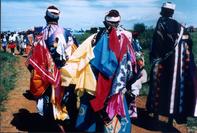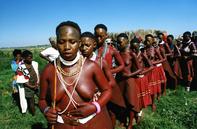Initiation of Basotho Men
For years before they were initiated, boys considered initiation as an important, exciting part of their upbringing, without which they could not participate in some social activities and affairs. A great deal of mystery surrounded the initiation school, which took place in a lodge 'mophato' built at a secluded place in the mountains, and boys did not know what to expect.

Before missionaries introduced schools, education took place during initiation, marking the passage to adulthood. The missionaries objected to initiation, and it became rare during colonial years, except among the Tlokoa in the mountains. In recent years, however, it has seen a major resurgence, and most young people today are initiated.
Initiation of Basotho Women

Basotho Girls between 15 and 20 were also initiated; the process was less gruelling than the boys', but its purpose was the same: to perform a ceremony that would bring adolescent girls into the adult world. It was also a desirable, though not essential, prelude to marriage, as it was sometimes believed to encourage fertility.
In some cases, when an uninitiated wife was infertile her husband would send her to be initiated.
Today initiation has a new, strong hold, tied in with a determination to use cultural activities as a mark of a Basotho identity and Africanness. While it follows similar patterns to those of the past, it has been altered to accommodate modern circumstances.
A particularly recognizable change is that contemporary initiation schools are of much shorter duration than in the past, although endurance tests remain as stringent.